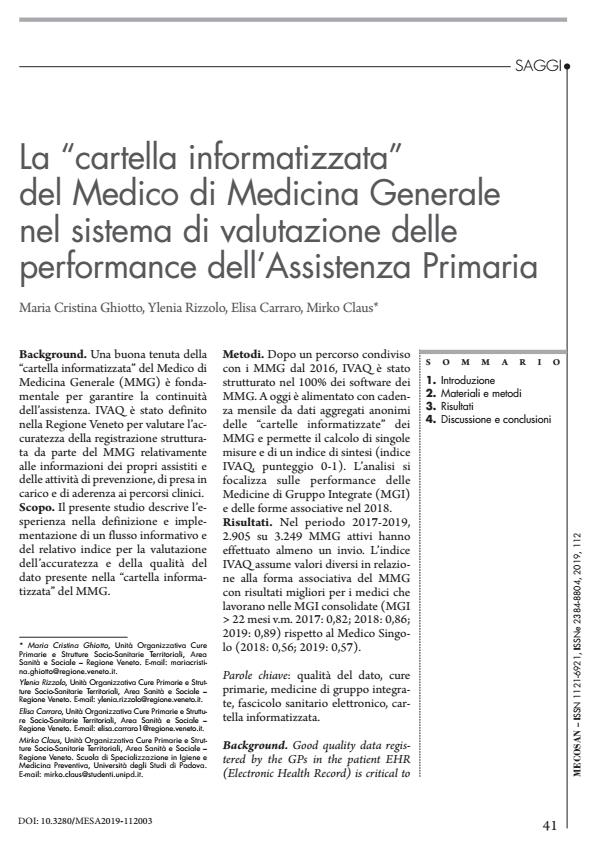La "cartella informatizzata" del Medico di Medicina Generale nel sistema di valutazione delle performance dell’Assistenza Primaria
Journal title MECOSAN
Author/s Maria Cristina Ghiotto, Ylenia Rizzolo, Elisa Carraro, Mirko Claus
Publishing Year 2020 Issue 2019/112
Language Italian Pages 19 P. 41-59 File size 873 KB
DOI 10.3280/MESA2019-112003
DOI is like a bar code for intellectual property: to have more infomation
click here
Below, you can see the article first page
If you want to buy this article in PDF format, you can do it, following the instructions to buy download credits

FrancoAngeli is member of Publishers International Linking Association, Inc (PILA), a not-for-profit association which run the CrossRef service enabling links to and from online scholarly content.
Background. Good quality data registered by the GPs in the patient EHR (Electronic Health Record) is critical to ensure the continuity of care and to improve health outcomes, but data completeness and accuracy in the primary care have been shown being sub-optimal. The Veneto Region has defined and implemented an additional information flow to collect anonymized aggregate data from GPs’ EHR to measure data registration quality in specific strategic areas: health promotion, disease prevention, chronic care and disease management programs. Objective. Our study describes the definition and the first results of the information flow designed to measure data accuracy and data quality of the GPs EHR in the Veneto Region. Methods. Developed in 2016 through a shared process involving GPs representatives, IVAQ has been structured in the EHR in particular to support Integrated Medical Group contract monitoring. Each month aggregate data are collected and used to calculate for each GPs single measures (prevalence, indicators), and a composite index, the IVAQ index (score 0-1). Results. Since 2017, 2905 on 3249 GPs have sent their data at least once through IVAQ. The IVAQ index scores differently according to the organizational model adopted by GPs (MGI > 22 months mean value 2017: 0,82; 2018: 0,86; 2019: 0,89 vs. Single Physician mean value: 2018: 0,56; 2019: 0,57).
Keywords: Data quality, primary care, integrated medical group, electronic health record, organizational models.
Maria Cristina Ghiotto, Ylenia Rizzolo, Elisa Carraro, Mirko Claus, La "cartella informatizzata" del Medico di Medicina Generale nel sistema di valutazione delle performance dell’Assistenza Primaria in "MECOSAN" 112/2019, pp 41-59, DOI: 10.3280/MESA2019-112003